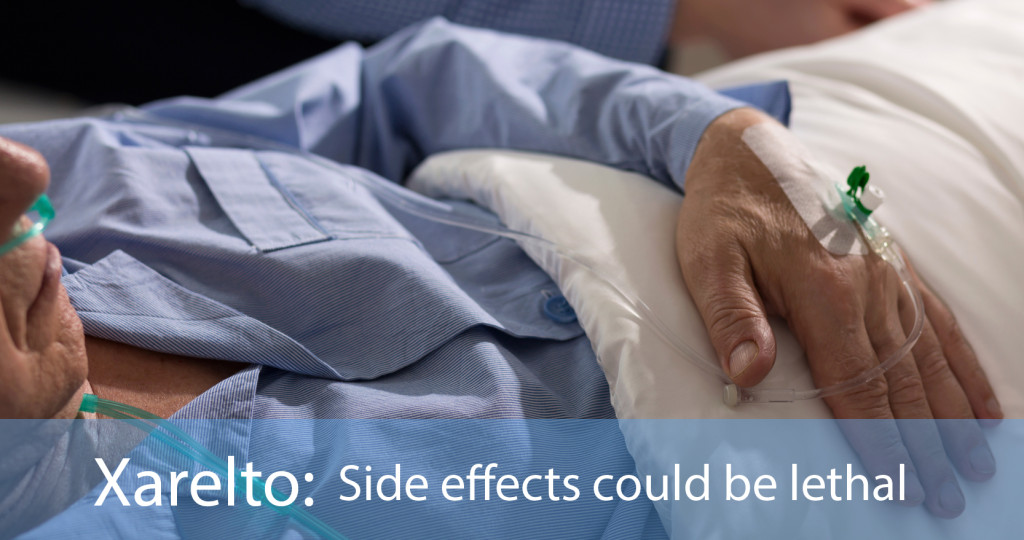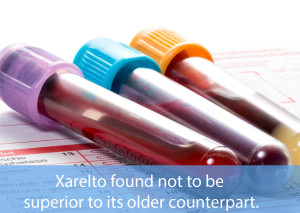Xarelto side effects can be deadly and require immediate hospital care. Rivaroxaban is a Novel Oral Anticoagulant (NOAC) marketed in the US by Bayer and Janssen with the brand name Xarelto (BAY 59-7939). It was the first direct Factor Xa inhibitor that could be taken orally when it was launched in 2008. Many international regulatory agencies granted approval to this anticoagulant for many indications such as the treatment and prophylaxis of deep vein thrombosis (DVT) in patients who underwent knee or hip replacement operations. The US Food and Drugs Administration (FDA) also approved it to reduce the risk of stroke in patients affected by pulmonary embolism (PE) and non-valvular atrial fibrillation [1].
Xarelto’s activity depends on its ability to interrupt both the extrinsic and intrinsic and pathways of the blood coagulation cascade by inhibiting Factor Xa. Since its mechanism of action is unique and peculiar, no antidote is available [2], so any internal bleeding could be very dangerous for patients treated with this drug. Plaintiffs filed several Xarelto lawsuits after a beloved one suffered from an internal bleedings that in some instances caused his or her death. Janssen Pharmaceuticals and Bayer have been brought to court with the accusation of concealing critical safety information. The pharmaceutical companies did not adequately warn the public about the drug’s serious threats, and they’re also accused of not testing the medication enough before releasing it on the US market.
Any mistake while administering this medicine can have devastating and sometimes lethal consequences on the patient’s health since no approved antidote can reverse the dangerous internal bleedings it may cause. Rivaroxaban has been included in the list of high-alert drugs from the Institute for Safe Medication Practices (ISMP) since it has a “heightened risk of causing significant patient harm.” Its dangerousness has been further underline by the FDA, who included in the blood thinner’ label some of the most serious contraindications and warnings such as intracranial and gastrointestinal bleeding. Xarelto is also dangerous because of a serious risk of permanent paralysis. Patients undergoing spinal puncture or receiving anesthesia can be affected by a harmful spontaneous spinal epidural hematoma.
The risk of uncontrolled internal hemorrhaging has always been observed with all anticoagulant drugs. However, the incidence of serious bleeding acccidents observed in subjects treated with Xarelto was just slightly higher than in those treated with Warfarin (4.3% vs. 3.1%). Nonetheless, a bleeding caused by Warfarin can be still stopped by rapid administration of vitamin K or platelets. Although the older blood thinner’s effects can still have fatal consequences, doctors still have an effective option available to treat a patient and save his life life. An option they don’t have with rivaroxaban and other NOACs. While during the administration of Warfarin the patients requires a careful monitoring of their dietary regime, drug interactions and need to perform frequent blood testing to evaluate the safety and effectiveness of this medicine effectiveness and , and most importantly, to properly adjust its dosage, no such monitoring is required posing a greater risk of unexpected side effects.
To prove the alleged superiority of Xarelto over Warfarin, Bayer and Janssen tested it in the ROCKET AF clinical trial. 14,264 patients affected by atrial fibrillation were involved, but disappointingly enough for the pharmaceutical companies, the new drug was not found to be superior to its older counterpart. It was just determined to be “non-inferior,” meaning its effectiveness in preventing systemic embolism and strokes was equivalent to the one showed by Warfarin. The older anticoagulant was also probably sub-optimally administered to patients, as pointed out by one of reviewer of the FDA committee. The regulatory agency even required the Big Pharma to provide them with additional results from further studies since they weren’t able to adequately assess the drug’s bleeding and stroke risks.
Major bleeding accident rates in patients treated with blood thinners can be doubled if the patients takes any one non-steroidal anti-inflammatory drugs (NSAIDs), a groupof drugs from the most widely abused over-the-counter painkillers that includes Aspirin. In addition, sudden therapy discontinuation in patients treated with anticoagulants may have lethal consequences since it increases the danger of blood clots forming inside the brain. However there’s an mounting clinical evidence pointed out that Xarelto can even increase the risk of blood clots formation instead of preventing it, since many patients suffered from venous thromboembolism pulmonary edema. The ISMP discovered that in 2012, 356 patients reported disabling, serious or even lethal injuries caused by Xarelto. Almost half of them (158) consisted of thromboembolic events, and constituted the predominant severe side effect type reported.
[wp_ad_camp_3]
Bleeding events have been reported as the adverse effect with the highest risk during prescription drug treatment, demonstrating how therapy with anticoagulants is accompanied by dangerous risk. Those risks rare even higher than those that usually associated with chemotherapy agents such as carboplatin [13]. In 2011, another blood thinner, Pradaxa (Dabigatran), was held responsible of almost 4,000 serious adverse reactions that included 542 deaths It surpassed any other medicine in reports of stroke (644), acute renal failure (291), and hemorrhage (2,367 cases).
Very similar to rivaroxaban, dabigatran is a blood thinner that lacks an antidote to reverse its harmful effects that cannot be mitigated even if the dosage is reduced. Boehringer Ingelheim, the pharmaceutical company that manufactures it, had to face an overwhelming amount of litigations filed against it by plaintiffs who held them responsible for their relatives’ deaths. Eventually, the company opted to pay a $650 million settlement to ease thousands of disgruntled patients and their families. Bayer, on the other hand, keeps defending the safety of its own product Xarelto. Novel Oral Anticoagulants have been recently associated with a substantially increased risk of gastrointestinal haemorrhages, though. Evidence from the study pointed out that dabigatran can increase the risk of this side effect by 50%, while rivaroxaban showed a two-fold higher risk compared to Warfarin.
Article written by Dr. Claudio Butticè, Pharm.D.
Bibliographic References
[1]. FDA U.S. Food and Drug Administration Website: Xarelto full prescribing information. http://www.fda.gov/downloads/drugs/drugsafety/ucm280333.pdf (Accessed June 2015):
[2]. “Bleeding with dabigatran, rivaroxaban, apixaban. No antidote, and little clinical experience.” Prescrire Int. 2013 Jun;22(139):155-9.
[3]. Institute for Safe Medication Practices (ISMP) “ISMP List of High-Alert Medications in Acute Care Settings” https://www.ismp.org/tools/highalertmedications.pdf (Accessed June 2015)
[4]. Jaeger M, Jeanneret B, Schaeren S. “Spontaneous spinal epidural haematoma during Factor Xa inhibitor treatment (Rivaroxaban).” Eur Spine J. 2012 Jun;21 Suppl 4:S433-5.
[5]. Patel MR, Mahaffey KW, Garg J, et al; and the ROCKET AF Steering Committee, for the ROCKET AF Investigators. “Rivaroxaban versus warfarin in nonvalvular atrial fibrillation.” N Engl J Med. 2011;365(10):883-891.
[6]. J P Hanley “Warfarin reversal” J Clin Pathol. 2004 Nov; 57(11): 1132–1139.
[7]. Daniel S. Budnitz, M.D., M.P.H., Maribeth C. Lovegrove, M.P.H., Nadine Shehab, Pharm.D., M.P.H., and Chesley L. Richards, M.D., M.P.H. “Emergency Hospitalizations for Adverse Drug Events in Older Americans” N Engl J Med 2011; 365:2002-2012 November 24, 2011
[8]. Bruce L. Davidson, Sara Verheijen, Anthonie W. A. Lensing, Martin Gebel, Timothy A. Brighton, Roger M. Lyons, Jeffrey Rehm, Martin H. Prins: “Bleeding Risk of Patients With Acute Venous Thromboembolism Taking Nonsteroidal Anti-Inflammatory Drugs or Aspirin.” JAMA Intern Med. 2014;174(6):947-953. doi:10.1001/jamainternmed.2014.946.
[9]. Institute for Safe Medication Practices (ISMP) “QuarterWatch Monitoring FDA MedWatch Reports – Why Reports of Serious Adverse Drug Events Continue to Grow – October 3, 2012 – Data from 2012 Quarter 1” http://www.ismp.org/quarterwatch/pdfs/2012Q1.pdf (Accessed June 2015)
[10]. Food and Drug Administration Web site. “Adverse Event Reporting System (AERS). (2011)” http://www.fda.gov/Drugs/GuidanceComplianceRegulatoryInformation/Surveillance/AdverseDrugEffects/default.htm (Accessed February 2011).
[11]. Institute for Safe Medication Practices (ISMP) “QuarterWatch Monitoring FDA MedWatch Reports – Anticoagulants the Leading Reported Drug Risk in 2011 – May 31, 2012 – New Data from 2011 Quarters 3 – 4” http://www.ismp.org/quarterwatch/pdfs/2011Q4.pdf (Retrieved July 2015)
[12]. Paul Harper, Laura Young, Eileen Merriman: “Bleeding Risk with Dabigatran in the Frail Elderly” N Engl J Med 2012; 366:864-866
[13]. Frank Siebelt, Jonathan Gould, William Hardy: “Bayer faces law suits in United States over Xarelto: paper” http://www.reuters.com/article/2014/06/14/us-bayer-suit-idUSKBN0EP0HW20140614 Reuters website, June 14, 2014. (Accessed June 2015)

